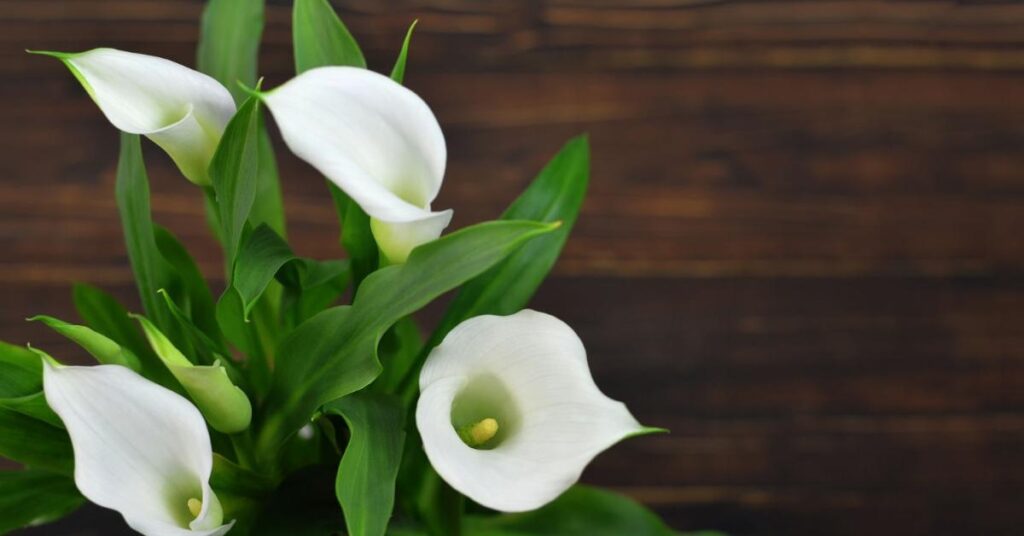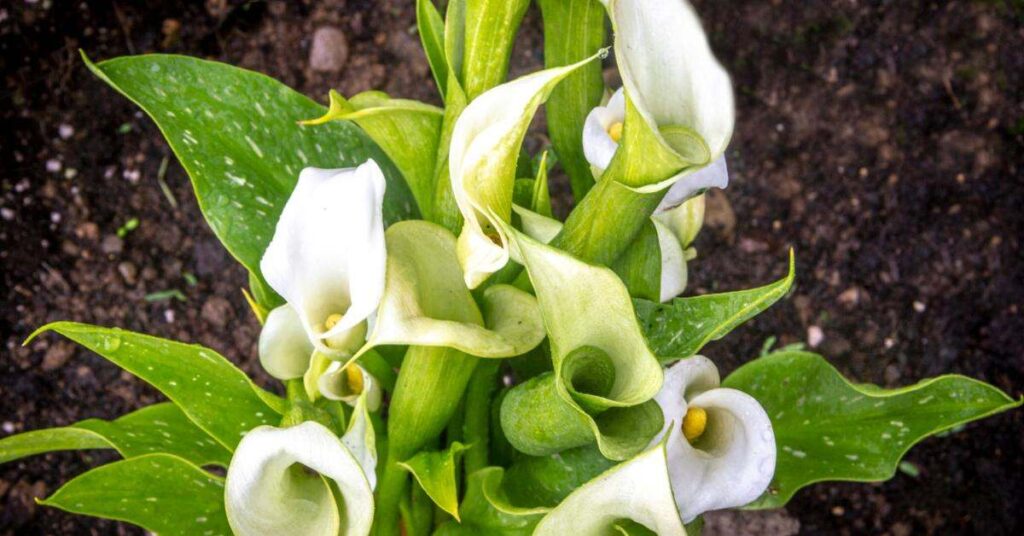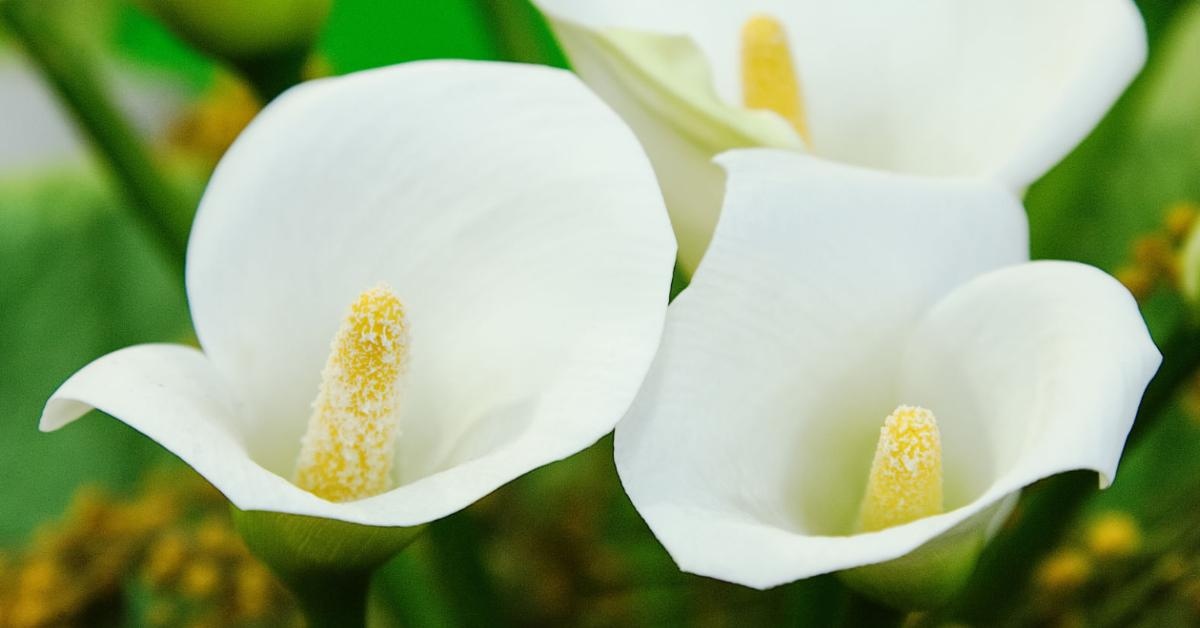What to do when your calla lilies droop?? It’s a question that we’ve all asked ourselves before! Calla Lilies stand out in any garden or bouquet with their unique, trumpet-shaped flowers and vibrant array of colors. Known for their elegance and simplicity, they are a favorite among gardeners and floral enthusiasts alike.
However, even the most well-cared-for Calla Lilies can sometimes face challenges, with drooping being a common issue that can detract from their beauty and vigor.
Understanding the reasons behind this phenomenon and knowing how to address it is crucial for maintaining the health and aesthetic appeal of these captivating plants. This article will explore the causes of drooping in Calla Lilies and offer practical solutions to rejuvenate and preserve their stunning allure.

Why Are My Calla Lilies Drooping?
There are several reasons why your calla lilies droop and let their heads hang, so let’s find out what they are.
Watering Issues
Water balance is crucial for the health of Calla Lilies, as both overwatering and underwatering can lead to drooping. Overwatering suffocates the roots by limiting oxygen access, causing root rot—a condition that weakens the plant and leads to drooping leaves and stems.
Underwatering, on the other hand, dehydrates the plant, making it unable to support the weight of its leaves and flowers, resulting in a wilted appearance. Signs of water stress include yellowing leaves (overwatering) or dry, crispy leaves (underwatering).
Checking the soil moisture can help determine the cause; it should feel moist but not waterlogged or bone dry. Adjusting your watering schedule to ensure consistent soil moisture levels is key to preventing droopiness due to water stress.
Light and Temperature Stress
Calla Lilies thrive in environments that provide them with ample, but not excessive, light. Too much direct sunlight can scorch their leaves, causing them to wilt and droop, while insufficient light leads to weak, elongated stems that can’t support the flowers properly.
The ideal lighting condition is bright, indirect light or partial shade, especially in hotter climates. Temperature stress can also cause drooping.
Calla Lilies prefer a temperate range of about 60-75°F (15-24°C). Temperatures outside this range, either too high or too low, can lead to stress-induced drooping. Protecting Calla Lilies from extreme temperatures by providing shade or moving them indoors during cold snaps can help maintain their vigor and prevent droopiness.

Nutritional Deficiencies
Nutritional balance is essential for the robust growth of Calla Lilies. A deficiency in key nutrients, such as nitrogen, phosphorus, and potassium, can lead to a variety of growth problems, including drooping leaves and stems.
Nitrogen is vital for leaf and stem growth, phosphorus for root and flower development, and potassium for overall plant health and disease resistance.
Symptoms of nutritional deficiencies include stunted growth, pale or yellowing leaves (nitrogen deficiency), weak stems, and fewer blooms (phosphorus deficiency), or brown edges on leaves and overall wilting (potassium deficiency). Regular application of a balanced, water-soluble fertilizer during the growing season can help prevent these deficiencies and keep your Calla Lilies thriving.
Pests and Diseases
Pests and diseases can wreak havoc on Calla Lilies, leading to drooping and other health issues. Aphids and spider mites suck sap from the leaves and stems, weakening the plant and causing drooping. Root rot, caused by overwatering and poor drainage, affects the plant’s foundation, leading to a lack of support for the stems and flowers, resulting in droopiness.
Other symptoms to watch for include discolored leaves, spots, and visible pests on the underside of leaves. Regular inspection and prompt treatment with appropriate insecticides or fungicides, along with good cultural practices like ensuring proper drainage and avoiding overhead watering, can help manage these issues and keep your Calla Lilies standing tall and healthy.
What to Do When Your Calla Lilies Droop
Drooping Calla Lilies can be a sign of distress, indicating that your plants are not receiving the care they need to thrive. Understanding how to address the specific needs of your Calla Lilies is crucial to reviving them. This section provides detailed strategies for correcting common issues that lead to drooping, ensuring your Calla Lilies regain their strength and beauty.

Correcting Watering Habits
Watering habits greatly influence the health of Calla Lilies. Establishing a balanced watering schedule is essential to avoid both underwatering and overwatering, which are common causes of drooping. The goal is to maintain consistent soil moisture.
Check the soil moisture by inserting a finger about an inch into the soil; it should feel moist, not saturated or dry. During the growing season, water your Calla Lilies when the top inch of soil feels dry to the touch. Reduce watering frequency during the dormant season to prevent root rot.
Adjusting watering according to weather conditions and the plant’s growth stage is also vital. Calla Lilies require more water during hot, dry periods and less during cooler, wetter times. Consider using a moisture meter for a more accurate reading, especially for potted plants.
Mulching around outdoor plants can help retain soil moisture and reduce the need for frequent watering. Proper drainage is equally important; ensure pots have drainage holes and the garden soil is well-draining to avoid waterlogging.
Adjusting Light and Temperature
Calla Lilies perform best in environments that offer optimal light and temperature conditions. They prefer bright, indirect sunlight.
When grown indoors, place them near a window where they can receive plenty of light without being exposed to the harsh midday sun. Outdoor Calla Lilies should be planted in a location that receives morning sunlight and afternoon shade, especially in regions with intense sunlight.
Temperature control is critical for preventing droopiness. Calla Lilies thrive in temperatures between 60-75°F (15-24°C).
Protect your plants from extreme temperatures by moving potted Calla Lilies indoors or to a shaded area during hot spells or cold snaps. Utilize protective coverings or frost cloths outdoors when unexpected frost is forecasted. Avoid placing indoor plants near air conditioning vents or heaters to prevent stress from sudden temperature changes.
Improving Nutrient Intake
Nutrient intake is fundamental to the overall health and vitality of Calla Lilies. Regular fertilization with a balanced, water-soluble fertilizer supports healthy growth and prevents drooping caused by nutritional deficiencies.
Apply fertilizer every four to six weeks during the growing season, following the product’s instructions to avoid over-fertilization, which can harm your plants.
Soil testing is a valuable tool for determining your soil’s nutrient levels and pH. This information allows you to make informed adjustments to your soil composition, ensuring that your Calla Lilies have access to the essential nutrients they need.
Amend the soil based on test results, incorporating organic matter, compost, or specific fertilizers to address deficiencies. Remember, healthy soil promotes healthy plants, reducing the likelihood of drooping and other health issues.
Managing Pests and Diseases
Pests and diseases can significantly impact the health of Calla Lilies, leading to drooping and other symptoms of distress. Regular monitoring is key to early detection and management of these issues. If you notice signs of pests or disease, such as discolored leaves, spots, or visible insects, take action immediately.
For pest infestations, such as aphids or spider mites, use insecticidal soap or neem oil, applying it according to the instructions. For fungal diseases like root rot, improve drainage, reduce watering, and remove affected plant parts. In severe cases, fungicides may be necessary, but always try cultural controls first to minimize chemical use.
Preventative measures include maintaining clean gardening practices, such as removing plant debris, avoiding overhead watering to reduce leaf wetness, and ensuring good air circulation around plants. Quarantine new plants before introducing them to your garden or home to prevent the spread of pests and diseases.
By addressing these four critical areas—watering habits, light and temperature conditions, nutrient intake, and pest and disease management—you can help your Calla Lilies recover from droopiness and enjoy their stunning beauty for years to come.
How to Prevent Calla Lilies from Drooping
Ensuring your Calla Lilies remain upright and vibrant involves proactive measures right from planting to their day-to-day care. Drooping can often be a sign of stress or unmet needs, but with the right practices, you can minimize these issues and enjoy the full beauty of these elegant flowers. Below are detailed strategies encompassing proper planting, routine care, and the vigilance required to keep your Calla Lilies flourishing.

Proper Planting Techniques
The foundation of a healthy Calla Lily begins with its planting. Select a location that receives partial sunlight, as Calla Lilies thrive in bright but indirect light. Avoid areas that are prone to waterlogging, as good drainage is essential to prevent root rot. When preparing the soil, incorporate organic matter to improve its structure and fertility, ensuring your Calla Lilies get a good start.
Spacing and depth are crucial for the healthy growth of Calla Lilies. Plant the rhizomes about 3 to 4 inches deep and space them approximately 12 inches apart to allow enough room for growth. Proper spacing helps in reducing the risk of disease and stress on the plants, contributing to a stronger, more resilient garden.
Routine Care and Maintenance
Consistent care is key to preventing your Calla Lilies from drooping. Watering should be done judiciously; keep the soil moist but not waterlogged, adjusting frequency based on weather conditions. Mulching can help retain soil moisture and regulate soil temperature, providing a stable environment for your Calla Lilies.
Lighting is another critical factor; ensure your plants receive sufficient but not excessive sunlight. Use shading techniques or reposition pots as necessary during peak sunlight hours to protect your plants.
Fertilizing your Calla Lilies with a balanced, slow-release fertilizer during their growing season will support their nutritional needs without overwhelming them. Regular pruning of dead or fading flowers and leaves will encourage healthier growth and flower production.
Seasonal care adjustments are essential. Reduce watering in the dormant season and protect outdoor Calla Lilies from frost by mulching or using frost cloths. For potted plants, consider moving them indoors if extreme temperatures are forecasted.
Monitoring for Early Signs of Stress
Regular inspection of your Calla Lilies can catch early signs of stress or disease, allowing for timely intervention. Look out for changes in leaf color, spots, or the presence of pests. Early detection of issues like aphid infestations or fungal diseases can be addressed more effectively, preventing further damage.
Implement preventive measures such as proper spacing, avoiding overhead watering, and maintaining clean garden practices to reduce the risk of disease. If you notice signs of stress, adjust care practices accordingly. For example, if leaves are turning yellow, evaluate and adjust your watering habits or consider a soil test to check for nutrient deficiencies.
By adopting these practices, you’re not just preventing your Calla Lilies from drooping; you’re ensuring they grow in a healthy, stress-free environment. This proactive approach to gardening will reward you with vibrant blooms and robust plants that are a testament to your attentive care.
What to Do When Your Calla Lillies Droop – Final Thoughts
Preventing Calla Lilies from drooping involves a combination of thoughtful planting, diligent care, and ongoing monitoring for any signs of stress or disease.
By understanding the specific needs of these elegant flowers—from the right soil and light conditions to the nuances of watering, fertilizing, and protecting them from pests and diseases—you can create an optimal environment for them to thrive.
Embrace these practices to not only prevent drooping but to also ensure your Calla Lilies remain a vibrant, beautiful highlight in your garden or home.
With a little effort and attention, you can enjoy the full splendor of these exquisite flowers, ensuring they stand tall and proud, showcasing their unique beauty to the world.
